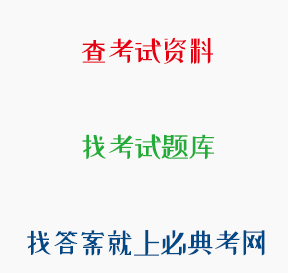正确答案: D
Exposure of a mass-market secret.
题目:What is the subject of the text?
查看原题 查看所有试题
学习资料的答案和解析:
[单选题]爱迪生在发明电灯之前做了两千多实验,有个年轻的记者曾经问他为什么遭遇这么多次失败。爱迪生回答:“我一次都没有失败。我发明了电灯。这只是一段经历了两千步的历程。”爱迪生之所以说“我一次都没有失败”,是因为他把每一次实验都看作
整个实践过程中的一部分
解析:B【解析】此题考查的是实践观点。实践的形式包括生产劳动、科学实验以及处理社会关系的实践。爱迪生发明电灯的实验属于实践形式中的科学实验,是属于实践的一部分。
[多选题]海的“贯通东流”水系的形成年代。如果说上游的沉积物从青藏高原、四川盆地顺廷而下能到达下游,这就表是胀江贯通了,这就是物源示踪。我国科学家采用这一方法以,研究长江中下游盆地沉积物的来源,从而判别长江上游的物质何时到达下游,间接指示了长江贯通东流的时限。他们经过10多年的研究,提出长江贯通东流的时间距今约2300多万年。这一研究成果从一个侧面显示出
时间和空间的通过物质运动的变化表现出来的
时间和空间是物质运动的存在形式
解析:BD(时间和空间是通过物质运动的变化表现出来的;时间和空间是物质运动的存在形式)
[多选题]抗日民主政府在工作人员分配上实行“三三制”原则。即共产党员、非党的左派进步分子和不左不右的中间派各占1/3。这是抗日民主政府在政权建设方面的一个重要内容-对“三三制”政权性质的表述,正确的有
是共产党领导的抗日民族统一战线性质的政权
是一切赞成抗日又赞成民主的人们的政权
是几个革命阶级联合起来对于汉奸和反动派的民主专政
解析:为了容纳各方面的代表,团结一切赞成抗日又赞成民主的各阶级、阶层,扩大统一战线的力量,抗日民主政府在工作人员分配上实行“三三制”原则。根据地的抗日民主政权,是共产党领导的抗IEl民族统一战线性质的政权,它以工农联盟为基础,是共产党领导的一切赞成抗日又赞成民主的人们的政权,是几个革命阶级联合起来的政权。抗日民主政权普遍采取民主集中制,各级抗日民主政权机构的领导人都经过人民选举产生。BCD正确,A是新民主主义社会的政权性质,不符题意。
[多选题]展望未来社会,是否坚持科学的立场、观点和方法是马克思主义与空想杜会主义的根本区别,在于
在揭示人类社会发展一般规律的基础上指明社会发展的方向
在剖析资本主义社会旧世界中阐发未来新世界的特点
立足于揭示未来社会的一般特征,而不作详尽的细节描绘
解析:展望未来社会,是否坚持科学的立场、观点和方法是马克思主义与空想社会主义的根本区别:第一,在揭示人类社会发展一般规律的基础上指明社会发展的方向。第二,在剖析资本主义社会旧世界中阐发未来新世界的特点。第三,立足于揭示未来社会的一般特征,而不作详尽的细节描绘。所以,正确答案是ABC,而D说法不对,因为马克思主义不可能揭示了社会主义的具体实现途径和方式。
[多选题]中国特色社会主义道路之所以完全正确。之所以能够引领中国发展进步.关键在手既坚持科学社会主义的基本原则又根据我国实际和时代特征赋予其鲜明的中国特色。党的十八大赋予中国特色社会主义道路以新的含义,包括有
社会生态文明
促进人的全面发展
逐步实现人全体人民共同富裕
解析:中国特色社会主义道路:就是在中国共产党领导下,立足基本国情,以经济建设为中心,坚持四项基本原则,坚持改革开放,解放和发展社会生产力,建设社会主义市场经济、社会主义民主政治、社会主义先进文化、社会主义和谐社会、社会主义生态文l!}i,促进人的全面发展,逐步实现全体人民共同富裕,建设富强民主文明和谐的社会主义现代化国家。党的十七大对这条道路的概括包括四个方面:①坚持党的领导。②一个中心两个基本点。③四位一体的总体布局。④奋斗目标。党的十八大政治报告对中国特色社会主义道路新定义增加了.:社会生态文明,促进人的全面发展,逐步实现全体人民共同富裕。ABC正确。D是“三步走”战略的第三步目标,不符题意。
[单选题]根据以下材料,回答{TSE}题[A] Some archaeological sites have alwaysbeen easily observable—for example, the Parthenon in Athens, Greece, the pyramids of Gizain Egypt; and the megaliths of Stonehenge in southern England. But these sitesare exceptions to the norm. Most archaeological sites have been located bymeans of careful searching, while many others have been discovered by accident.Olduvai Gorge, an early hominid site in Tanzania, was found by a butterflyhunter who literally fell into its deep valley in 1911. Thousands of Aztecartifacts came to light during the digging of the Mexico City subway in the1970s. [B]In another case, American archaeologistsRene Million and George Cowgill spent years systematically mapping the entirecity of Teotihuacan in the Valley of Mexico near what is now Mexico City. Atits peak around AD 600, this city was one of the largest human settlements inthe world. The researchers mapped not only the city’s vast and ornateceremonial areas, but also hundreds of simpler apartment complexes where commonpeople lived. [C] How do archaeologists know where tofind what they are looking for when there is nothing visible on the surface ofthe ground? Typically, they survey and sample (make test excavations on) largeareas of terrain to determine where excavation will yield useful information.Surveys and test samples have also become important for understanding thelarger landscapes that contain archaeological sites. [D] Surveys can cover a single largesettlement or entire landscapes. In one case, many researchers working aroundthe ancient Maya city of Copan, Honduras, have located hundreds of small ruralvillages and individual dwellings by using aerial photographs and by makingsurveys on foot. The resulting settlement maps show how the distribution anddensity of the rural population around the city changed dramatically between AD500 and 850, when Copan collapsed. [E] To find their sites, archaeologiststoday rely heavily on systematic survey methods and a variety ofhigh-technology tools and techniques. Airborne technologies, such as differenttypes of radar and photographic equipment carried by airplanes or spacecraft, allowarchaeologists to learn about what lies beneath the ground without digging. Aerialsurveys locate general areas of interest or larger buried features, such asancient buildings or fields. [F] Most archaeological sites, however, arediscovered by archaeologists who have set out to look for them. Such searchescan take years. British archaeologist Howard Carter knew that the tomb of theEgyptian pharaoh Tutankhamun existed from information found in other sites.Carter sifted through rubble in the Valley of the Kings for seven years before helocated the tomb in 1922. In the late 1800s British archaeologist Sir ArthurEvan
[单选题]Which of the following can be inferred from the lase paragraph?
根据以下资料,回答下面的题目。In the 2006 film version of The Devil Wears Prada, Miranda Priestly, played by Meryl Streep, scold her unattractive assistant for imagining that high fashion doesn’t affect her.Priestly explains how the deep blue color of the assistant’s sweater descended over the years from fashion shows to department stores and to the bargain bin in which the poor girl doubtless found her garment.This top-down conception of the fashion business couldn’t be more out of date or at odds with feverish world described in Overdressed, Elizabeth Cline’s three-year indictment of “fast fashion”.In the last decades or so, advances in technology have allowed mass-market labels such as Zara, H&M, and Uniqlo to react to trends more quickly and anticipate demand more precisely.Quckier turnrounds mean less wasted inventory, more frequent releases, and more profit.Those labels encourage style-conscious consumers to see clothes as disposal—— meant to last only a wash or two, although they don’t advertise that——and to renew their wardrobe every few weeks.By offering on-trend items at dirt-cheap prices, Cline argues, these brands have hijacked fashion cycles, shaking all industry long accustomed to a seasonal pace.The victims of this revolution, of course, are not limited to designers.For H&M to offer a 5.95 knit miniskirt in all its 2300-plus stores around the world, it must rely on low-wage, overseas labor, order in volumes that strain natural resources, and use massive amount of harmful chemicals.Overdressed is the fashion world’s answer to consumer activist bestsellers like Michael Pollan’s The Omnivore’s Dilemma.Mass-produced clothing, like fast food, fills a hunger and need, yet is non-durable, and wasteful,” Cline argues, Americans, she finds, buy roughly 20 billion garments a year——about 64 items per person——and no matter how much they give away, this excess leads to waste.Towards the end of Overdressed, Cline introduced her ideal, a Brooklyn woman named SKB, who, since 2008 has make all of her own clothes——and beautifully.But as Cline is the first to note, it took Beaumont decades to perfect her craft; her example, can’t be knocked off.Though several fast-fashion companies have made efforts to curb their impact on labor and the environment——including H&M, with its green Conscious Collection Line——Cline believes lasting-change can only be effected by the customer.She exhibits the idealism common to many advocates of sustainability, be it in food or in energy.Vanity is a constant; people will only start shopping more sustainably when they can’t afford to it.Priestly criticizes her assistant for her
People are more interested in unaffordable garments.

 川公网安备 51012202001360号
川公网安备 51012202001360号